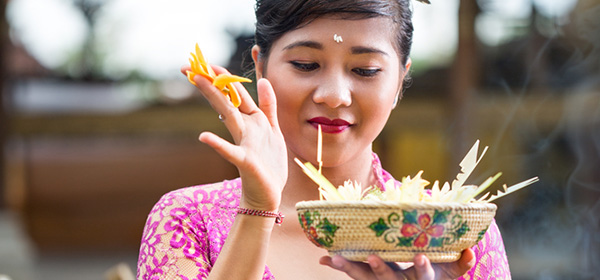One thing all cultures have in common when they celebrate is food. From the sugar skulls of Mexico’s Dia de Muertos to the pumpkin pie of Thanksgiving in the US, the use of food to celebrate is a thread that binds us.
Our Christmas lunch is quite possibly the singularly most celebrated meal in Australia. It is a meal that brings families together, often for the only time all year. The following photographs show how other cultures use food to celebrate their special rituals and occasions, illustrating the multitude of ways that food is sacred to us all.
Hindu New Year feast

Govardhan Puja, also known as Annakut (meaning a heap of grain), is the Hindu New Year celebrated on the fourth day of Deepawali (Hindu festival of lights) between October and November each year.
As part of the celebration, a huge pile of food is created, which symbolises a mountain believed to have been lifted by Lord Krishna to save the people from the wrath of another vengeful god. Some displays, such as this one at the Neasden Temple in London, consist of over 1000 offerings, organised from sweet at the top to savoury at the bottom.

Click NEXT to see more sacred food festivals.
La Rejunta – Mexico

The December feast of La Rejunta celebrates the yearly pilgrimage to Chalma in Mexico, where believers travel to a sanctuary known as the second-most important pilgrimage site in Mexico. It is there that the image of the ‘black Christ’ is said to have miraculously appeared in cave.
The village of Chalma almost solely exists to service these pilgrims, and in December each year they prepare over 30,000 tamales for those who have made the journey. Traditionally, the women prepare the tamales and the men cook them.


Click NEXT to see more sacred food festivals.
All Souls’ Day – Philippines
In honour of All Souls’ Day, celebrated on 2 November, family members gather at the gravesites of relatives to eat a meal in honour of the dead. The holiday falls a day after All Saints’ Day, which honours saints and all who have entered heaven.

When food itself is worth praise

You don’t have to be religious to appreciate the value of food, especially when Christmas lunch may be the biggest and best meal you’ve had all year, and possibly the only one you’ve had for a while. This man at a mission in the Bowery, New York, prays and gives thanks for his Christmas cuisine.
Click NEXT to see more sacred food festivals.
Iftar – breaking the fast

Iftar is the evening meal taken when Muslims end their daily Ramadan fast at sunset. Muslims traditionally gather as a community to break their fast together, either before or after the Maghrib prayer, which is around sunset. Typically, they eat three dates to break their fast in the same way as the Islamic Prophet Muhammad broke his fast. The types of food served as Iftar are dependant on the traditional cuisine of the country in which the meal is eaten.

Click NEXT to see more sacred food festivals.
Kolyadki celebration– Belarus / Ukraine

The pagan winter holiday known as Kolyadki falls on 7 January – the same time as Orthodox Christmas. Villagers celebrate the pagan festival by dressing in costumes, singing Ukrainian carols and eating a sumptuous feast at their home.


Click NEXT to see more sacred food festivals.
Dia de Muertos


Día de Muertos, or Day of the Dead, is celebrated throughout Mexico, particularly in the central and south regions, as well around the world. During this holiday, family and friends gather to pray for and remember loved ones who have died, building ofrendas (private altars) out of sugar skulls, marigolds, and the favourite foods and drinks of their dearly departed to help support their spiritual journey in the afterlife.
Do you follow the way of celebrating traditional Christmas? Or does your family background or culture mean you do things differently? Why not tell us how you celebrate Christmas
Read more at National Geographic

